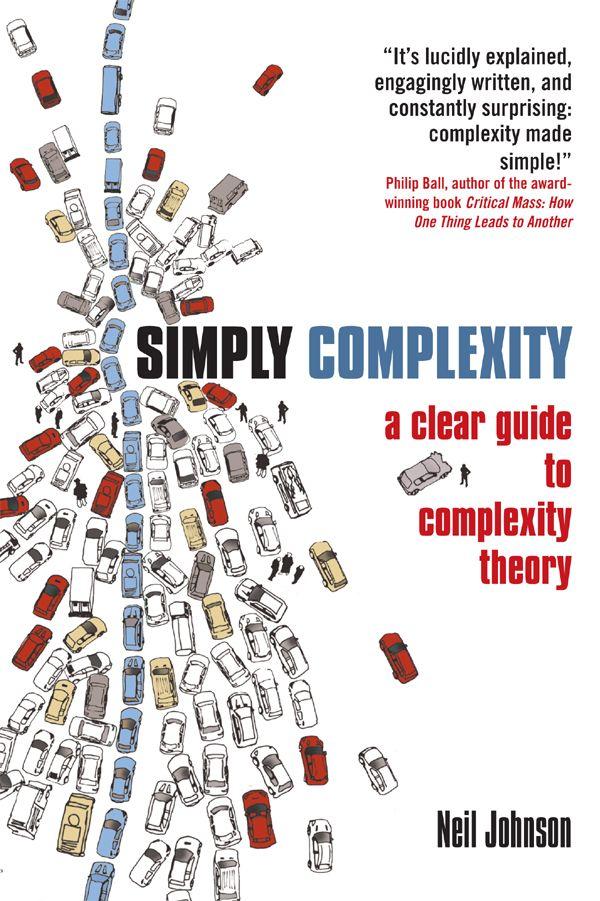Simply Complexity
Authors: Neil Johnson


Simply Complexity
Neil Johnson is the head of a new inter-disciplinary research group in Complexity at the University of Miami in Florida. He was previously Professor of Physics and co-director of research collaboration into Complexity at Oxford University. He does research on a wide variety of real-world Complex Systems, and is an author of
Financial Market Complexity
(Oxford University Press, 2003). He enjoys the complex things in life, like overcrowded bars and the fastest route home from work.
A Clear Guide to Complexity Theory
Neil F. Johnson

A Oneworld Book
First published in hardcover by oneworld Publications
as
Two’s Company, Three is Complexity
2007
First published in trade paperback as
Simply Complexity
2009
Reprinted 2009, 2010
This ebook edition published by Oneworld Publications 2011
Copyright © Neil Johnson 2007
All rights reserved
Copyright under Berne Convention
A CIP record for this title is available
from the British Library
ISBN 978–1–78074–049–2
Typeset by Jayvee, Trivandrum, India
Cover design by D. R. ink
Oneworld Publications
185 Banbury Road
Oxford OX2 7AR
England
Learn more about Oneworld. Join our mailing list to find out about our latest titles and special offers at:
Chapter 1: Two’s Company, Three is Complexity
Chapter 2: Disorder rules, OK?
Chapter 3: Chaos and all that jazz
Chapter 6: Forecasting financial markets
Chapter 7: Tackling traffic networks and climbing the corporate ladder
Chapter 8: Looking for Mr./Ms. Right
Chapter 9: Coping with conflict: Next-generation wars and global terrorism
9.3 The universal pattern underlying modern wars and terrorism
Chapter 10: Catching a cold, avoiding super-flu and curing cancer
Chapter 11: The Mother of all Complexities: Our nanoscale quantum world
11.3 The secret nanoscale life of plants, bacteria and brains
Chapter 12: To infinity and beyond
It is 2050, and you are watching
Who Wants to be a Billionaire?
The contestant is one question away from the jackpot. Up comes his question: “What is the name of the theory that scientists started developing at the beginning of the twenty-first century, and which helped the world overcome traffic congestion, financial market crashes, terrorist attacks, pandemic viruses, and cancer?” The contestant cannot believe his luck. What an easy question! But he is so nervous that his mind temporarily goes blank. He starts to consider option A: “They are all still unsolved problems” – but then quickly realizes that this is a dumb answer. Instead, he uses his last lifeline to ask the audience. The audience responds unanimously and instantaneously with option B: “The Theory of Complexity”. Without hesitation, he goes with option B. The host hands him the cheque, and the world has yet another billionaire.
Pure fantasy? Maybe not.
In this book, we will go on a journey to the heart of Complexity, an emerging science which looks set to trigger the next great wave of advances in everything from medicine and biology through to economics and sociology. Complexity Science also comes with the prospect of solving a wide range of important problems which face us as individuals and as a Society. Consequently, it is set to permeate through every aspect of our lives.
There is, however, one problem. We don’t yet have a fully-fledged “theory” of Complexity. Instead, I will use this book to
assemble all the likely ingredients of such a theory within a common framework, and then analyze a wide range of real-world applications within this same common framework. It will then require someone from the future – perhaps one of the younger readers of this book – to finally put all these pieces into place.
Complexity Science is a double-edged sword in the best possible sense. It is truly “big science” in that it embodies some of the hardest, most fundamental and most challenging open problems in academia. Yet it also manages to encapsulate the major practical issues which face us every day from our personal lives and health, through to global security. Making a pizza is complicated, but not complex. The same holds for filling out your tax return, or mending a bicycle puncture. Just follow the instructions step by step, and you will eventually be able to go from start to finish without too much trouble. But imagine trying to do all three at the same time. Worse still, suppose that the sequence of steps that you follow in one task actually depends on how things are progressing with the other two. Difficult? Well, you now have an indication of what Complexity is all about. With that in mind, now substitute those three interconnected tasks for a situation in which three interconnected people each try to follow their own instincts and strategies while reacting to the actions of the others. This then gives an idea of just how Complexity might arise all around us in our daily lives.
While I was writing this book, I had the following “wish-list” in my head concerning its goals:
1. To provide a book which a wide cross-section of people would want to read and would enjoy reading – regardless of age, background or level of scientific knowledge.
2. To introduce readers to the exciting range of real-world scenarios in which Complexity Science can prove its worth.
3. To provide the book on Complexity that “I never had but always needed”. In other words, to provide an easily readable yet thorough guide to this important scientific revolution.
4. To provide a book that my kids could read – or rather, a book that they would actually
choose
to read all by themselves. This is a very important goal, since Complexity will likely become
the
science of interest for future generations.
5. To provide a book which is just as readable on a plane or bus as in a library. As such, it should also make sense when read in short chunks.
6. To provide a book which provides professional scientists, economists, and policy-makers with a new perspective on open problems in their field, and to help stimulate new Complexity-based interdisciplinary research projects.
